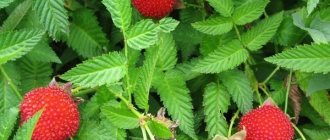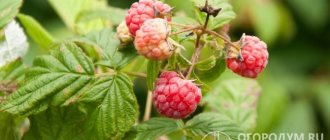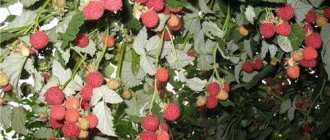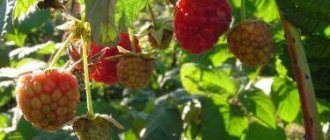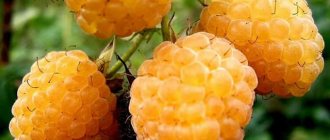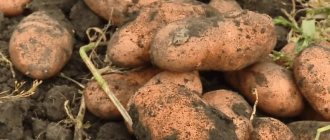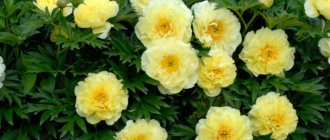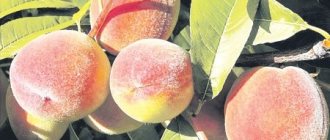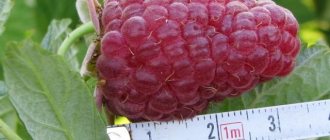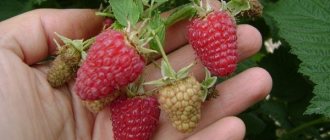Description of raspberry Hercules
This variety was developed by Russian breeder I.V. Kazakov, crossing Ottom Bliz and No. 14-205-4.
Hercules is a remontant variety - in one growing season it gives 2 harvests: in July (fruits form on last year's stems) and in August (berries ripen on young shoots).
The bushes are slightly spreading. They reach a height of two meters. The shoots are powerful and the fruits do not tilt them down. Therefore, there is no need to use trellises. Young stems are green, while those that have reached the age of one year acquire a purple color and a waxy coating. The stems are completely covered with thorns.
The size of the berries matches their name. The average weight is 6-10 grams, but some specimens reach 15 grams. They are cone-shaped and painted a bright ruby color. The fruits are dense but juicy, have a pleasant sweet and sour taste and a pronounced raspberry aroma. Taste qualities are rated 4 points.
2.5-4 kilograms of berries are harvested from one bush. When harvesting, you should use a small container to avoid crushing the delicate berries.
This variety is successfully grown in both home and industrial gardens.
Properties and characteristics of the plant
The raspberry variety “Hercules” is remontant, productive, and large-fruited. The bushes are compact, the activity of shoot formation is moderate. The stems are of medium height (up to 180-200 cm), straight, strong, not prone to lodging and do not need support. There are many thorns, they are located along the entire length of the shoots. The leaves are green, large, without pubescence.
The bushes are compact, the stems are erect, strong, do not lie to the ground under the weight of berries and do not require support
Characteristics of berries
The berries are bright red, in the shape of a wide cone with blunt tips, dense, large, with a classic “raspberry” aroma. The average weight is about 10 g, the largest ones can weigh up to 15 g. The yield is high: with good care, each plant produces up to 3-4 kg of berries per season. The fruits tolerate short-term storage and transportation well, and retain their shape during heat treatment (in compote or jam). The purpose is universal.
The berries have an attractive presentation and large size, suitable for fresh consumption and all types of processing.
According to the originator, the berries contain:
| Nutrients and beneficial substances | Quantity |
| Sahara | 9,8% |
| Acids | 1,3% |
| Vitamin C | 32 mg% |
There is no clear opinion about the taste of the berries of this variety. Officially, it is rated 4 points (out of 5), and many consumers consider it not too sophisticated, but quite worthy. However, the quality of Hercules raspberry fruits, according to gardeners, very much depends on parameters such as soil composition and climatic characteristics of the growing region.
When planting on “poor” soils, it is necessary to apply a large portion of organic fertilizers to each seedling, and feed the bushes in the spring and several times during the season. Without this, the berries become smaller and become tasteless, acquiring excess sourness. In areas with cool and damp summers, raspberry fruits are large and beautiful, but watery and almost tasteless. In the southern regions, Hercules raspberries ripen sweet, although not so sweet as to compete with many more sugary varieties.
Photos from sites offering planting material for raspberries of the Hercules variety
Advantages of the variety
Nevertheless, this type of popular culture has a number of undoubted advantages. One of the most important is the possibility of obtaining a harvest in the “raspberry off-season”. This is what berry growers call the period in mid-summer, when the earliest varieties have already finished bearing fruit, and the later ones have not yet ripened. Raspberries “Hercules” when cultivated as an annual crop (that is, with radical pruning of bushes in the fall and summer fruiting “in one wave”) begins to ripen a little earlier than other remontant varieties. In this case, ripe berries are harvested already in mid-July, thereby making up for the temporary shortage of raspberries on the market. This property of the variety is also useful for summer residents, especially those who cultivate several varieties of crops that have different ripening periods.
Cultivation of the variety as an annual crop involves radical pruning of bushes in the fall
Among the other advantages of the variety, it is worth noting the following:
- unpretentiousness . Raspberries tolerate temperature fluctuations and short-term droughts well. On most soils (except for the “leanest”) it does not require abundant fertilizing;
- ease of care . The bushes are low and can be grown without trellises. Few root shoots are formed. There are enough new shoots to reproduce, but the plantings do not thicken. With radical autumn pruning, protection from frost is not required (except, perhaps, mulching in case of severe frosts in the absence of snow);
- resistance to diseases and low susceptibility to pests;
- large-fruited;
- the versatility of using berries, their suitability for transportation;
- yield , which is assessed as consistently high.
Specifics of cultivation
Most of the shortcomings of the Hercules raspberry are associated not so much with the qualities of the plant itself, but with attempts to cultivate it in not entirely suitable conditions. To be fair, gardeners can only complain about the strong thorniness of the shoots, which really interferes with raspberry cultivation and harvesting.
The disadvantages of the variety include strong thorniness along the entire length of the shoots, which makes caring for plants and harvesting difficult.
The variety is initially not recommended for cultivation in regions with cool and short summers, and for good reason: the fruiting period of remontant raspberries is greatly extended, berries set at the end of summer do not have time to ripen even when cultivated as an annual crop. If a summer resident tries to get two harvests in a season, in addition to this problem, he is faced with others: the need to cover last year’s shoots for the winter and damage to the flower buds that form on them, which are often subject to spring frosts. In general, the variety can be considered quite worthy, but it is better to cultivate it in the southern regions. In this case, the gardener can freely choose the method of pruning the bushes and the mode of their fruiting.
Landing
Unlike most other remontant varieties, Hercules produces a large amount of shoots that can be used for propagation.
You can plant seedlings in any soil. But they prefer sandy or loamy soil, characterized by weak acidity.
For a raspberry garden, you should choose a well-lit area, protected from drafts, in the southern part of the site. It may get dark in the morning.
Seedlings are planted in the spring (April-May), before the buds begin to open, or in the fall (September-October), when the growing season ends.
Holes for planting (50x50 centimeters) should be prepared in advance (3 weeks). The third part of the holes is filled with a soil mixture to which humus (10 kilograms), superphosphate (20 grams) and potassium sulfate (80 grams) are added.
The seedlings are placed in holes and covered with earth, pressing it down well so that no voids form. The root collar should be located 3-5 centimeters above the soil surface. The bush is watered and mulched using compost or peat.
Plants are planted at a distance of 80 centimeters from each other. The optimal distance between rows is one and a half meters.
You can also propagate raspberries by cuttings. Before planting, the cuttings are sprinkled with charcoal. Plant them in containers and water them regularly. After the cuttings take root (this process takes about a month), they are transplanted to a permanent place.
To prevent the roots from spreading throughout the area, the raspberry tree is fenced off.
Features of planting and growing
In addition to the general rules for planting and caring for raspberries, each variety requires an individual approach in these matters.
Landing
Raspberry is a heat- and light-loving plant. Therefore, to plant the Hercules variety, you should select an area sheltered from the cold wind and well lit by the sun. With partial shading, this raspberry also bears fruit well.
Planting should be done during the plant's dormant period. The best time for planting is spring (before buds appear) or autumn. When buying seedlings, special attention should be paid to the root system: it should be well developed, without signs of mold or rot.
For successful rooting, raspberry seedlings must have a developed root system
Hercules is unpretentious to soil conditions and grows successfully on almost any soil, except highly acidified or depleted soil. If such soils are present on the site, their preliminary cultivation will be required: fertilization and the application of chalk or dolomite.
Since raspberries begin to “spread” beyond the boundaries of their site over time, you can immediately dig limiters (for example, old slate) around the beds to a depth of 0.5 m.
When preparing the soil for planting raspberries, first of all, perennial weeds are removed, fertilizers are applied and deep digging is done. Raspberries can be planted in rows or small groups. The second method is recommended for small gardens. Raspberry seedlings are placed at a distance of 60–70 cm from each other. There should be 1.2–1.5 m between rows.
The procedure for planting raspberries consists of the following steps:
- For row planting, prepare a trench 3 shovels wide and 1 bayonet deep. The bottom is covered with an 8–10 cm layer of humus, mixed with a pitchfork and covered with a layer of soil.
- Seedlings are carefully inspected before planting, and dried or broken roots are removed. Place in a trench, carefully straightening the roots. The planting depth should be no more than 8 cm.
The distance between raspberry seedlings should be 60–70 cm, between rows - 1.2–1.5 m
- Holding the seedling vertically, cover the roots with soil and compact it with your hands. The stem is cut to a bud 25–30 cm from the ground.
- Water the seedlings at the rate of 5–6 liters of water for each and mulch the soil. Watering should be repeated after a couple of days.
Raspberry care
In the first spring after planting, you need to cut off the old stem when young shoots appear. This will improve the rooting conditions of seedlings. Further care consists of watering, fertilizing, pruning and protection from pests. This variety of raspberries does not need staking, since the strong stems do not bend under the weight of the berries.
Watering
Raspberry Hercules, unlike most other varieties, is not very moisture-loving. But to ensure high yields, watering should be carried out regularly. It is recommended to fill the raspberry plantation with water so that the soil is saturated to a depth of 30–40 cm. Moistening begins in the second half of May and continues until mid-August. Pre-winter watering is carried out in October. It is not necessary to moisturize Hercules raspberries too often; once every 10–12 days is enough (in dry and hot weather this interval is shortened).
Trimming
Raspberries require regular pruning. There are several methods:
- Autumn pruning. The bush is shortened to a height of 30–35 cm. The following year, the remaining shoots produce young shoots, providing the first summer harvest. Its volume is usually 30% of the annual one.
- Winter pruning at the root. 12–15 days before the onset of frost, raspberry bushes are cut completely down to soil level. This method makes it possible to get one harvest, but a plentiful one.
- May pruning. Before flowering begins, the stems are trimmed. This allows you to increase the second harvest many times over.
- Autumn shortening. Instead of heavy pruning, the upper part of the stems, 40–45 cm long, is removed. With this method, the volume of the first harvest increases to 55–60% of the annual one.
During winter pruning, fruit-bearing shoots are cut off at ground level.
For pruning, use a well-sharpened garden pruner. Before and after use, it should be washed with soap. If any diseases are detected on the raspberries, the pruning shears are disinfected with alcohol. The cut shoots are burned.
Raspberry bushes are prone to thickening, which entails a reduction in the size of the berries. To prevent this from happening, all excess (too thin) growth should be removed.
Recent Entries
5 working ways to use tar in the garden 7 indoor plants that help you get married even in adulthood Indoor plants that can bloom in trouble
Soil care
One of the keys to successfully growing raspberries is regularly loosening the soil and weeding out weeds. Loosening begins in the spring, then repeats 5-6 times per season after watering to prevent crusting.
Since the Hercules raspberry is not highly frost-resistant, it needs shelter in winters with little snow. To protect the root system, you should mulch the ground around the bush with a thick layer of sawdust (or agrofibre) within a radius of 20–25 cm. In the spring, you need to rake the layer of sawdust to the side.
Fertilizer application
If raspberries are planted on poor soils, the bushes will develop poorly and become sick, and the berries will not gain sufficient size and taste. Therefore, it is necessary to provide plants with nutrients in a timely manner. Fertilizers are scattered dry in a 0.5-meter strip on both sides of the row, mixed with the soil with a pitchfork and watered.
- The first feeding of raspberries is done in the spring, before the first leaves bloom. To stimulate shoot growth, nitrogen fertilizers are applied during this period (for example, 15 g/m2 of ammonium sulfate).
- In autumn, plants are fed with potassium sulfate (30 g/m2). Every three years, it is recommended to add 55–60 g/m2 of superphosphate to the autumn fertilizing.
When nitrogen fertilizer standards are exceeded, raspberry fruiting is delayed and reduced due to increased growth of green mass.
In summer, you can carry out foliar feeding with a mixture of urea (50 g), superphosphate (250 g), potassium sulfate (70 g) and boric acid (10 g) per bucket of water. In addition to mineral fertilizers, regular application of organic matter is necessary - 5 kg/m2 of humus or rotted manure.
Video: caring for remontant raspberries
Top dressing
Fertilizers are applied 3 times per season:
- in May, when the berries appear;
- in July, when fruiting begins;
- in August-September, when buds are laid for the future harvest.
In the spring, a solution of mullein (half a liter per bucket of water) or dry ammonium sulfate is added under the bush.
In summer, plants are sprayed with a solution prepared from superphosphate, potassium sulfate, urea and boric acid.
In autumn, superphosphate and potassium salt or humus are added to the soil.
Pests and diseases
Hercules has strong disease resistance, the variety is less susceptible to gray rot and other fungal diseases, and is resistant to raspberry mite.
Aphid
Shoot aphids often settle in entire colonies at the ends of shoots, penetrating into raspberry inflorescences.
Leaf aphids, which eat the underside of leaves, cause great harm to the plant, as they literally suck all the vital juice out of the plant. With significant damage to the raspberry bush by aphids, slow death of the plant and a decrease in yield are observed.
In order to destroy it, the affected bushes are sprayed with carbosphorus or actellik during the raspberry bud bursting period. This should be done immediately, as aphids spread very quickly.
Raspberry beetle
Another frequent visitor to raspberry plants. The insect is large in size (up to 4 mm); it can be identified by its yellow-gray hairs.
Overwintering in the soil under a raspberry bush, in mid-spring the beetle moves into raspberry buds and actively destroys them.
During the period of bud formation, experienced gardeners recommend shaking off pests from the bushes and then burning them. During the period of pupation of larvae, it is advisable to dig up the soil.
Also, for control purposes, it is advisable to spray the raspberries with confidor or its equivalent. It is necessary to periodically check the bushes and manually remove beetles from them.
Bud moth
The adult looks like a butterfly with dark brown wings and golden spots. In the caterpillar state, the moth has a reddish color. This is what is dangerous for raspberries.
Spending the winter in the cracks of the stem, in the spring the caterpillars move to the shoots and begin to gnaw out the buds, then penetrate into the pulp of the shoot. They lay eggs in raspberry flowers, from which caterpillars hatch and eat the berries.
As a control, complete pruning of shoots at the root while preparing the shrub for winter is suitable.
During the period of swelling of the buds, for prevention, it is advisable to treat the bushes with any of the following:
- Confidor,
- Ditsis,
- Iskora,
- Emulsion of karbofos.
Treatment is carried out twice a year, along with trimming unnecessary stems.
Trimming
Proper pruning allows you to regulate the number of fruitings. In autumn, the tops of young shoots are cut off, and two-year-old stems are cut at the root. Damaged and dry shoots are also removed.
Some gardeners cut out all the stems at the root. In this case, the raspberries will give only one harvest, but it will be of higher quality.
Plant care
Watering
Watering for raspberries is almost crucial. This crop is demanding on moisture, but there is no need to overdo it here either. On average, up to 4 liters of water are consumed per bush.
Contrary to popular belief, watering is required not at the root, but in trenches that can be dug next to the bushes.
As an option, sprinkling is used, which in dry weather has a beneficial effect, evenly moistening the soil under the raspberries. Another thing is that it needs to be carried out in the morning or evening hours, when there is no direct sunlight.
Imitating rain when watering will help raspberries absorb moisture better and preserve it longer
The drip irrigation system allows those gardeners who can afford to visit their dacha only on weekends to live in peace. During the working week, while you are not on the site, water will be delivered to the raspberries in a certain amount on an ongoing basis, thereby maintaining the desired level of humidity.
Trimming
First, decide for yourself whether you will grow raspberries as a biennial crop or rely solely on annual shoots.
Two-year-old shoots produce a third of the total harvest, but at the same time they take away water and nutrients from annual shoots. By abandoning the “repeat” ones, you will lose part of the harvest, but in return you will receive the full development of the same year and, accordingly, high-quality fruiting with large and sweet berries.
Pruning is usually of a sanitary nature. Thanks to this event, raspberries get sick less often and tolerate winter cold well. To perform quality work, you need a disinfected and sharpened pruner or knife.
The best time for pruning is late autumn, a period of consistently low temperatures that occurs after the first frost, when fruiting ends.
Pruning raspberries hardens them and makes them more resistant to adverse environmental influences.
With standard pruning, only the roots remain, and all shoots are cut almost to ground level and must be burned. If you decide to use this year’s shoots next season, then cut only two-year-old ones. But in this case, in early spring (after the snow melts), inspect the bush for the presence of dry or frost-damaged stems and, if any are found, remove them immediately.
In addition, it is advisable to bend annual shoots left for the winter to the ground and tie them to pegs, and then cover them with spruce branches.
Do not delay bending the shoots, because the more frosts they survive, the less flexible they will become and, when bent to the ground, they may simply crack or break. It is best to do this business immediately after picking the last berries, right before the first frost.
Raspberry feeding
Raspberry feeding is seasonal and is usually carried out in three stages.
- In the spring, while the plant is actively growing, use a solution of chicken manure. It is made as follows: take a kilogram of fertilizer per bucket of water. The resulting mixture is usually enough for one bush.
- Manure (horse or cow) is used as mulch. To make the structure of the mixture less dense, add sawdust or straw. Placed in trenches for irrigation.
- Peat or humus is used in the amount of 5 buckets, sometimes urea (150 g) or ammonium nitrate is added.
Preparing bushes for winter
You have already learned about sheltering annual shoots left for the winter. The situation is even simpler with stems cut at the root: they only require a mulching layer about 5 cm thick, consisting of dry leaves or sawdust.
It should be noted that such a measure is necessary only in those areas where winters with little snow prevail. With good snow cover, additional cover is not required for the roots.
When storing raspberry shoots for the winter, bend them to the ground and cover them
Care
Hercules does not require special care. It is enough to regularly destroy weeds, loosen the soil, water and feed the plants. But if you pay more attention to raspberries, their yield will increase significantly.
It is recommended to regularly thin out the raspberry tree by cutting out the shoots. Otherwise, the yield will decrease and the fruits will be crushed.
Hercules is drought tolerant and can survive without watering. But to significantly increase the yield, raspberries are watered at the end of May, twice in June and July, at the beginning of August and in October. It is best to make furrows between the rows for watering. But you can also use sprinkling.
Loosening the soil is required to ensure the supply of oxygen to it. The first time weeding is done before the buds begin to bloom. Then the procedure is repeated when weeds appear or a crust forms.
To reduce the number of weedings, it is recommended to mulch the soil with humus, peat compost or sawdust.
For winter, the shoots are bent to the ground and covered with leaves or sawdust.
Raspberry variety “Daughter of Hercules”
Based on the variety, a variety was bred that is very similar to its predecessor, but has slightly different properties. This is the "Daughter of Hercules" raspberry. The new product has not yet been tested and has not been included in the State Register, but planting material can already be purchased, and some summer residents have managed to convince themselves of its undoubted advantages.
Photos from sites offering planting material for remontant raspberries of the “Daughter of Hercules” variety
In terms of resistance to adverse conditions, unpretentiousness and ease of care, as well as consumer qualities of the berries, the “daughter” almost completely replicates the “dad”. However, its fruits are larger (weighing on average from 10 to 20 g) and there are much more of them. For this plant, a yield of 6-7 kg per bush is far from the limit. Some gardeners report that in a successful summer they harvested up to 10 kg. The reason for such high productivity is the variety’s tendency to branch. With a competent approach to pinching the shoots, side branches quickly grow on them, on which flower clusters also form. Of course, not every summer resident can achieve maximum yields: this requires optimal climatic conditions that allow the remontant variety to fully realize its potential in each (early and late) wave of fruiting. However, “Daughter of Hercules” has already successfully “taken root” not only in the warm regions of the country, but also in areas with a more severe climate (in the middle zone and even beyond the Urals). This is a new, extremely promising variety that deserves the close attention of gardeners.
Advantages and disadvantages
Raspberries have several disadvantages:
- the presence of a large number of thorns;
- extended fruiting - some of the berries do not have time to reach maturity before frost;
- susceptibility to severe frosts.
But the advantages of the variety significantly outweigh its disadvantages:
- undemanding to soil: grows well and bears fruit even with a deficiency of nutrients and rare watering;
- drought-resistant;
- resistant to diseases and pests;
- bears fruit abundantly and for a long time;
- produces large berries;
- the fruits are well transported and have an excellent presentation;
- the berries are well preserved (they can remain in the refrigerator for a week without losing their presentation);
- the berries do not rot even in prolonged rainy weather.
Harvesting
The first harvest of the Hercules variety can be harvested in the first ten days of July, and the second fruiting begins in mid-August and can last until the first frost. Raspberries are harvested in dry weather. For long-term storage and transportation, it is recommended to collect the berries along with the stalk. It is better to use small flat baskets or plastic containers with holes as containers. Do not lay the collected berries in a thick layer - they are easily crushed under their own weight.
Fresh raspberries will keep in the refrigerator for 3-4 days. Due to their sour taste, the berries of the Hercules variety are usually used to make jams and compotes. Raspberries, grated with sugar, keep well. For long-term storage, berries can be frozen.
Reviews about the Hercules variety
You can hear completely contradictory reviews about Hercules. Some raspberry connoisseurs admire this variety, while others do not perceive it at all.
Most gardeners talk about the excellent taste of the berries. But some consider them too sour and argue that they are better used for jam and other preparations than fresh. Such differences of opinion are due to the fact that the taste of the berries depends significantly on weather conditions and soil composition. Fruits become less tasty with insufficient light and excessive humidity.
But no one has any complaints about the yield and size of the berries. Even prolonged rainy weather does not affect the appearance of the fruit.
All raspberry lovers agree that a significant drawback of the variety is the large number of thorns, which make harvesting difficult.
Gardeners living in the northern regions note that Hercules produces small harvests and often freezes out. Therefore, it is better to grow this variety in more southern regions.
Reviews
Reviews from gardeners about the remontant raspberry variety Hercules are mostly positive, but there are also comments.
Hercules is pleased with the variety, but with some reservations. Thorns are very annoying when harvesting. It’s inconvenient to pick berries with gloves, and without them you’ll rip and tear all over your hands. It is completely impossible for children to pick berries from such bushes. The taste of Hercules raspberries is very good, rather sweet than sweet and sour. It travels home well from the dacha and does not fall off during the working week, so the harvest is not lost. I don’t plan to give up the variety.
Tasty, but very prickly raspberries. My Hercules grows in the sun, and I don’t even feel the acidity in the taste. I like the way the berries behave when prepared – they almost don’t fall apart. The strong smell is especially good when making liqueurs and homemade liqueurs. Hercules was very pleased with the productivity and presentation. Almost all raspberries are now of this variety.
Remontant raspberry varieties are always valued by gardeners, and Hercules is no exception. Beautiful large berries on the bushes also look very decorative and brighten up the garden.
Possible pests
Raspberry Hercules is resistant to most diseases. It is rarely attacked by insects, but despite this, it is susceptible to viruses.
The main diseases of this variety:
- Rust. The outer part of the leaf blades is covered with yellow spots. Also, if this problem is present, the color of the stems changes. They become covered with small ulcers that have a gray tint. To cure raspberries from rust, you will need to treat the bush with a 1% solution of Bordeaux mixture. A good prevention of this disease is systematic loosening of the soil. Mulching also helps prevent rust from developing.
- Mosaic. This disease also affects leaf blades. They not only deform, but also change their shade. The middle part becomes darker than the edges. If nothing is done, the stems will thin and the fruits themselves will lose their taste. It is almost impossible to cure a bush from this disease. If such symptoms appear, the affected shoots must be removed as quickly as possible.
- Septoria. Plants that are affected by this infection are distinguished by leaves that have round brown spots. After some time they turn purple. Septoria blight is very dangerous, as it affects not only the leaves, but also the buds. At its first manifestations, the bushes need to be sprayed with 0.5% copper oxychloride. Excess fertilizers containing large amounts of nitrogen can lead to this problem.
Also a common cause of poor fruit formation is an excessive number of shoots. This problem is called overgrowth. Sometimes one bush can grow up to 200 branches. Often they are all very thin and are not capable of producing crops. To get rid of this problem, the bush needs to be cut down and burned. This is the only and effective method. Removing the plant will prevent the virus from spreading to other crops.
By following the rules for planting and caring for remontant Hercules raspberries, you can get a high-quality and abundant harvest. The berries of this variety will have a rich aroma and incredible taste that will not leave anyone indifferent.
Diseases and pests, methods of control and prevention
Despite the high resistance to pests and diseases, the following diseases can occur if not properly cared for:
| Diseases and pests | Symptoms | Treatment and prevention |
| Anthracnose | Dark brown spots appear on the shoots and leaf blades. | 14 days before flowering, the bush is treated with copper-containing preparations. |
| Purple spot | The stems turn purple. | Treatment with Bordeaux mixture. Prevention - loosening the soil and removing weeds. |
| Raspberry aphid | The leaf blade curls and dries out. | Treatment with Karbofos and Fufanon. If aphids are found, the top is cut off and burned. |
| Raspberry beetle | The berries are affected by small yellow worms. | Treatment of the bush with Fitosporin. Affected berries are collected and burned. |
Advantages
The main advantages of the Hercules raspberry variety include:
- high productivity;
- the berries ripen in two stages - first on two-year-old shoots, and then on stems grown in the current season;
- the harvested crop tolerates transportation well at various distances;
- the first fruits can be collected from seedlings planted in spring;
- the possibility of growing this variety for further sale of the crop, because the fruits continue to ripen on the shoots until the onset of cold weather;
- bushes do not require special care;
- the raspberry variety Hercules is highly resistant to major diseases that affect other varieties of this berry perennial;
- The resistance to cold of the variety varies: if the shoots are not pruned for the winter, then the frost resistance is average, when the stems are pruned, it is high;
- It is possible to grow this raspberry with a minimal addition of the mineral complex.
How to plant
This raspberry loves the sun, so it needs to be planted in a well-lit area. It is advisable to choose a place in the southern part of the garden. This should not be a lowland, since water stagnates in such areas and the snow melts later. It is better that the plantings are protected from the wind by a fence or buildings. The soil in this place should be loose, fertile, with low acidity. It is advisable to fertilize it with humus or rotted manure. To reduce acidity, add lime.
Important! This variety cannot be planted after nightshade crops or strawberries. There should not be any near the raspberry tree, nor sea buckthorn or grapes. In the place where other varieties grew, Hercules can be planted only after 5 years.
To plant, you need to choose the right time. Suitable spring or autumn depending on climatic conditions. You just need to take into account that in the spring the bushes will quickly take root and begin to grow. If you plant them on time - when the ground thaws and there is no frost for more than a week, after 3 months you can pick the first berries.
It is best to plant the Hercules variety in a well-lit area with sunshine.
But with spring planting, the harvest will be smaller. Therefore, it is most often recommended to plant Hercules raspberries in the fall. The best time is the end of September - beginning of October. The bushes will take root before frost. Since the variety is frost-resistant, young plantings tolerate winter well. You just need to mulch the root areas with peat to a height of 15-20 cm. With this planting in early spring, the plants will begin to grow and the first berries will appear in June. Already this year it will be possible to harvest two good harvests.
How to choose seedlings
It is very important to plant high-quality planting material. It is necessary to buy seedlings not at the market, but in special stores or nurseries. Only then can you be sure that you have purchased the right variety.
When buying seedlings, you need to carefully consider them. The root system must be well developed, all roots are alive, without rot or mold. It is desirable that there are no blackened areas or dry roots. The bush should have 2-4 shoots with a thickness of 1 cm.
Planting process
It is advisable to buy seedlings immediately before planting. 2-3 weeks before this you need to dig up the selected plot of land. Remove all debris, branches, and weed roots. When digging, it is recommended to add 10 kg of manure or humus, 30-50 g of potassium nitrate and 50-80 g of superphosphate for each square meter of soil. If the soil is very acidic, add 600 g of lime. The soil needs to be loosened well.
It is better to plant Hercules raspberries in trenches. They are dug in a direction from north to south so that all the bushes are illuminated by the sun. The width and depth of the trench should be 50 cm. A distance of 1.5-2 m should be made between the rows. After this, pour 5 cm of rotted manure onto the bottom. On top is a layer of fertile soil mixed with ash (300-400 g per 1 m2). For planting, prepare mounds for seedlings at a distance of 0.7-1 m.
The step-by-step planting process will help you do everything correctly and avoid mistakes.
- Dip the roots of the seedlings into the Kornevin solution for 2-3 hours. This will help strengthen them and protect them from disease.
- Lower the seedling onto the prepared mound. In this case, the root collar should be at ground level.
- Spread the roots well.
- Sprinkle them with fertile soil in several stages, spilling them with water. Then there will be no voids left, and the seedling will not fall.
- Compact the soil and finally water it. Each bush should have a bucket of water.
- It is recommended to shorten the shoots by 30 cm so that all the strength of the plant goes into rooting.
- At the final stage of planting, a layer of mulch of at least 10 cm is poured. Before winter it may be larger. Peat, sawdust, hay, and onion peels are suitable for mulching.
Properly planted plants will take root well and produce a large harvest.
Young plants need to be watered after 1 week. Then water as the soil dries out. The variety is resistant to drought, but with a lack of moisture, the yield decreases.
Flaws
- The berries are partially covered with thorny branches, it can be problematic to find and collect them in a timely manner; the variety is generally very thorny.
- With the last selections, the berries become smaller. It also loses size and shape in extreme heat and lack of moisture.
- During prolonged rains, the fruits may become soggy.
- Hercules produces a large amount of root shoots. For care this is a big minus, for reproduction it is a significant plus.
- Weak growth vigor, raspberries produce few replacement shoots.
- Poor taste (average and below) and insufficient sugar content in the berries.
Plant pruning
To keep raspberries healthy, it is enough to adhere to proper watering and loosening the soil. Also, do not forget about fertilizing.
This raspberry variety is resistant to rotting. The bushes cope well with waterlogged soil.
Pruning raspberries is also important. The main problem with the lack of a bountiful harvest is the thickened bushes. Therefore, to prevent this, it is recommended to periodically trim the shoots. Branches that are thinner than a pencil should be removed. They will not be able to produce a harvest and will harm the development of fertile shoots.
In order for the remontant Hercules raspberry to look like in the photo, you should use one of 4 pruning methods:
- Standard. It is held only in the spring. To do this, remove all shoots, leaving no more than 30 centimeters from each. If everything is done correctly, the raspberry will send out young branches, which at the beginning of the season will give 30% of the harvest, and at the end - 70%.
- To the root. Such cutting should be carried out before the onset of frost. This should be done about 14 days before the first frost. Using root pruning, the harvest will be more abundant, but the first berries will appear somewhat later than with standard pruning.
- Double pruning of bushes. The first procedure should be carried out after the ovary begins to form. This period falls in mid-May. If the shoots are removed on time, the second harvest will be many times higher than expected.
- Removing the tops. You need to cut the bushes this way in the fall. The top shoots should be removed by 40 centimeters. In this case, the initial harvest will be about 60% of the total.
Such procedures should only be carried out with a sharp knife. You can also do this with pruning shears. If you cut with other devices, there is a possibility of damaging the shoots, and they will begin to lose their abilities.
It should also be noted that if pruning is done in the fall, it is not necessary to cover the bushes for the winter. This is especially true for those plants around which mulch is laid.
